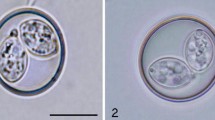Abstract
Experimental infections of Galba truncatula with Paramphistomum daubneyi were carried out to determine at day 50 (at 24°C) the numbers of sporocysts, which grew in infected snails via the count of first- and second-generation rediae. In snails individually exposed to one, two, three, four, or five miracidia, the numbers of first-generation rediae increased from the one-miracidium group to the five-miracidium snails (from a mean of 6.7 to 26.1), while second-generation rediae decreased in number (from 6.2 to 0.9, respectively). This scale of redial numbers was used to determine the number of sporocysts, which grew in naturally infected snails collected from sedimentary or acid soils between 1993 and 2006. In cercariae-containing snails, natural infections resulting from the development of one to five sporocysts were found in both samples of G. truncatula examined. The numbers of 3-, 4-, and 5-sporocyst infections were increasing over time since 1997, 2000, and 2003, respectively. The utility of such multiple-sporocyst infections is open to question, as the differentiation of second-generation rediae and that of procercariae were delayed and always limited. They might be interpreted as a consequence of a zoonosis, which has been spreading since 1990 in ruminants of central France.

Similar content being viewed by others
References
Abrous M (1998) Les mollusques hôtes et les formes larvaires de Paramphistomum daubneyi Dinnik, 1962 (Trematoda) dans le centre de la France. Influence d’une co-infestation avec Fasciola hepatica Linné, 1758. Ph D Thesis, Univ Limoges
Abrous M, Rondelaud D, Dreyfuss G (1997) Paramphistomum daubneyi: the development of redial generations in the snail Lymnaea truncatula. Parasitol Res 83:64–69
Dreyfuss G, Vignoles P, Rondelaud D (2003) Natural infections of Omphiscola glabra with Fasciola hepatica in central France. Parasitol Res 91:458–461
Mage C, Bourgne H, Toullieu JM, Rondelaud D, Dreyfuss G (2002) Fasciola hepatica and Paramphistomum daubneyi: changes in prevalences of natural infections in cattle and in Lymnaea truncatula from central France over the past 12 years. Vet Res 33:439–447
Ollerenshaw CB (1971) Some observations on the epidemiology of fascioliasis in relation to the timing of molluscicide applications in the control of the disease. Vet Rec 88:152–164
Rondelaud D, Barthe D (1982) Les générations rédiennes de Fasciola hepatica L. chez Lymnaea truncatula Müller. A propos des effets de plusieurs facteurs. Ann Parasitol Hum Comp 57:245–262
Rondelaud D, Vignoles P, Dreyfuss G (2004) Fasciola hepatica: the developmental patterns of redial generations in naturally-infected Galba truncatula. Parasitol Res 94:183–187
Rondelaud D, Fousi M, Vignoles P, Moncef M, Dreyfuss G (2007) Optimization of metacercarial production for three digenean species by the use of Petri dishes for raising lettuce-fed Galba truncatula. Parasitol Res 100:861–865
Stat-Itcf (1988) Manuel d’utilisation. Institut Technique des Céréales et des Fourrages, Service des Études Statistiques, Boigneville
Author information
Authors and Affiliations
Corresponding author
Rights and permissions
About this article
Cite this article
Dreyfuss, G., Vignoles, P. & Rondelaud, D. Paramphistomum daubneyi: the number of sporocysts developing in experimentally and naturally infected Galba truncatula . Parasitol Res 103, 345–349 (2008). https://doi.org/10.1007/s00436-008-0978-4
Received:
Accepted:
Published:
Issue Date:
DOI: https://doi.org/10.1007/s00436-008-0978-4




